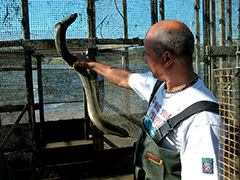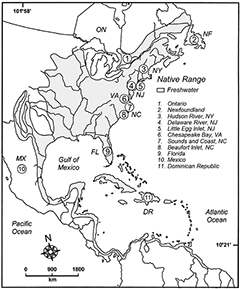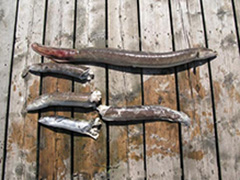

USGS scientist takes aim at Great Lakes invaders
Rising Higher: A Research Lab Built from the Ground Up - Part 2
Great Lakes Researchers Go Down Under
Rising Higher: A Research Lab Built from the Ground Up - Part 1
A Monograph on Ciscoes of the Laurentian Great Lakes and Lake Nipigon
WATCH: Acoustic Telemetry Provides In-Depth Look into Fish Behavior
Eel-Ladder Style Traps: A New Lamprey Control Tool
A Lampricide Treatment: Up-Close
Lamprey Nativeness Claims Annulled by Commission's Eshenroder
A Population at the Edge: American Eel Declining at the Extremes
Celebrating 60 Years of Successful Sea Lamprey Control, Science, and Cross-Border Collaboration!
Great Lakes Scientists Use Acoustic Telemetry to Reveal the Secret Lives of Fish
Hammond Bay Biological Station: The Nexus for Research and Restoration on the Great Lakes
Big Consequences of Small Invaders
New Sea Lamprey Estimates Suggest a Dramatically Decreased Population
Conducting Research through Cooperative Partnerships: The PERM Agreement
Living on the Edge: A Closer Look at Coastal Communities
Asian Carp: The War Isn't Over
Managing the Lake Huron Fishery
Understanding Sea Lamprey: Mapping the Genome and Identifying Pheromones

- Taking Lampreys on the Road!
- Great Lakes Scientists Use Acoustic Telemetry to Reveal the Secret Lives of Fish
- Great Lakes Fishery Commission Hosts Workshop to Explore Lampricide Resistance and the Development of Next Generation Lampricides
- Celebrating 60 Years of Successful Sea Lamprey Control, Science, and Cross-Border Collaboration!
- A Population at the Edge: American Eel Declining at the Extremes
A Population at the Edge: American Eel Declining at the Extremes
New research shows widespread declines of the American eel are most severe in the extremities of its range
The American eel is one of the most unique and mysterious native species in the Great Lakes - and it's also one of the most imperiled. American eel populations in the Great Lakes and St. Lawrence River system have declined by more than three orders of magnitude since 1992, in some areas dropping from over 20,000 eels per day migrating up eel ladders at regional dams to just a few eels per week. And as the eels have disappeared, so too have once-valuable commercial fisheries in North America. In Ontario, the decline was so dramatic that in 2007 the American eel was officially designated under the Species at Risk Act as "endangered". Now, new commission-funded research by John Casselman (Queen's University) and collaborators from the Ontario Ministry of Natural Resources, New Jersey Division of Fish and Wildlife, Department of Fisheries and Oceans, and National Oceanic and Atmospheric Administration shows that declines as severe as in the St. Lawrence River - Great Lakes system are happening throughout the range, particularly in the extremities.
The range of the American eel spans almost the entire eastern seaboard of North America: as far south as the Caribbean, as far north as Greenland, and inland as far as the St. Lawrence and Mississippi river systems. There is only a single spawning ground for this widespread species: the Sargasso Sea, an area of the Atlantic Ocean offshore of the southeastern United States and Caribbean. The young, willow-leaf-like eels hatched in the sea will drift in the Gulf Stream, changing into clear, darning-needle-sized "glass eels" and eventually swimming into the fresh waters of North America, where they will spend up to 20 years living in rivers and lakes before returning to the sea to spawn.
As American eels make this long migration, they experience many threats along the way. When newly hatched eels drift away from their natal area in the Sargasso Sea, unfavorable ocean currents and altered temperature due to climate change may reduce their ability to find coastal regions. For those that do locate the coast, a gauntlet of obstacles awaits their passage through freshwater rivers, including large dams, hydroelectric power turbines, and other human-made obstructions that block their migration or even kill the eels. Additionally, all stages of the American eel life cycle are affected by over-harvest for food, bait, and now aquaculture.
With American eels threatened at every life stage and at almost all points in their migration, a large-scale study of American eel populations was direly needed to document whether the threats are amassing to cause declines across the entire range, and if so, what management actions can be taken to rectify the declines. To address this need, Casselman and colleagues completed a study that examined changes in abundance across the entire range of the American eel, including the St. Lawrence River system, the northern Gulf of St. Lawrence, the Atlantic coastal states, Gulf of Mexico, and Caribbean. A total of eighteen datasets from commercial fisheries and agency population assessments, usually encompassing two to five decades, were assembled from four different countries (Canada, the United States, Mexico, and the Dominican Republic), including separate datasets for two provinces and five states.
The alarming finding of Casselman's work was that severe declines are common at the extremities of the American eel's range. "With these long-term time series of eel recruitment and abundance, declines in the extreme parts of the eel's range are apparent, widespread, and consistent with an overall species decline" said Casselman, concluding that "we should consider the species to be threatened across the entire range and associated fisheries endangered."
The study concluded that management actions, particularly those that increase the survival of spawning eels, are urgently needed. Managers have already closed Ontario fisheries and have stocked American eels in the upper St. Lawrence River and Lake Ontario. Also, many dams and hydropower facilities now have eel ladders to allow migrating eels to pass safely, but additional management action is needed. "Increasing egg production of the spawning population could compensate for some of the major stressors, such as overfishing, turbine mortality, and changing oceanic conditions," explained Casselman.
In a strong appeal for cooperative action, Casselman urged, "We plead that this work does not fall on deaf ears. The American eel is an important indicator and universal integrator. The dramatic decline of American eels across their range sends a strong message of human impact on the aquatic environment, its fish and fisheries." Casselman wonders, "Are these signals being heeded?" but hopes that universal recovery actions for the species and its aquatic environment are finally underway.
For more information about American eels, see: Eels at the Edge: Science, Status, and Conservation Concerns edited by John Casselman and David Cairns, American Fisheries Society Symposium 58, Special Publication, American Fisheries Society, Bethesda, Maryland, 2009.

The American eel is imperiled throughout its range. A new study has shown that American eel declines are most severe at the extremes of the species range. PHOTO: J. CASSELMAN

The native range of the American eel spans almost the entire eastern seaboard of North America and the Caribbean. Locations used in the study by Casselman and colleagues to document a species-wide decline of American eels are numbered. [Click to expand the map.] FIGURE: J. CASSELMAN

Hydroelectric turbines kill large numbers of American eels (such as the eels shown here) as they migrate downstream in rivers, heading toward the Atlantic Ocean. Eels that safely reach the ocean will continue on to the Sargasso Sea to spawn. PHOTO: R. BORG



